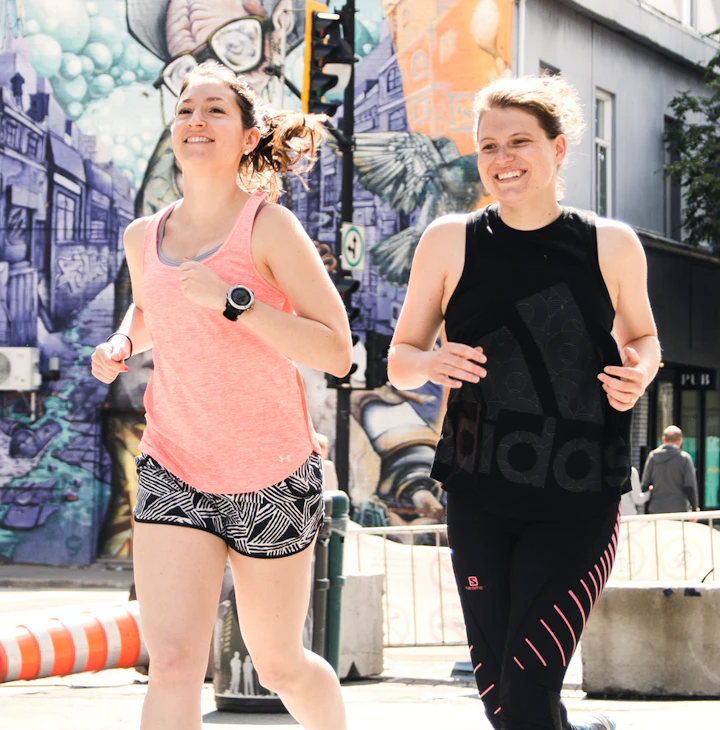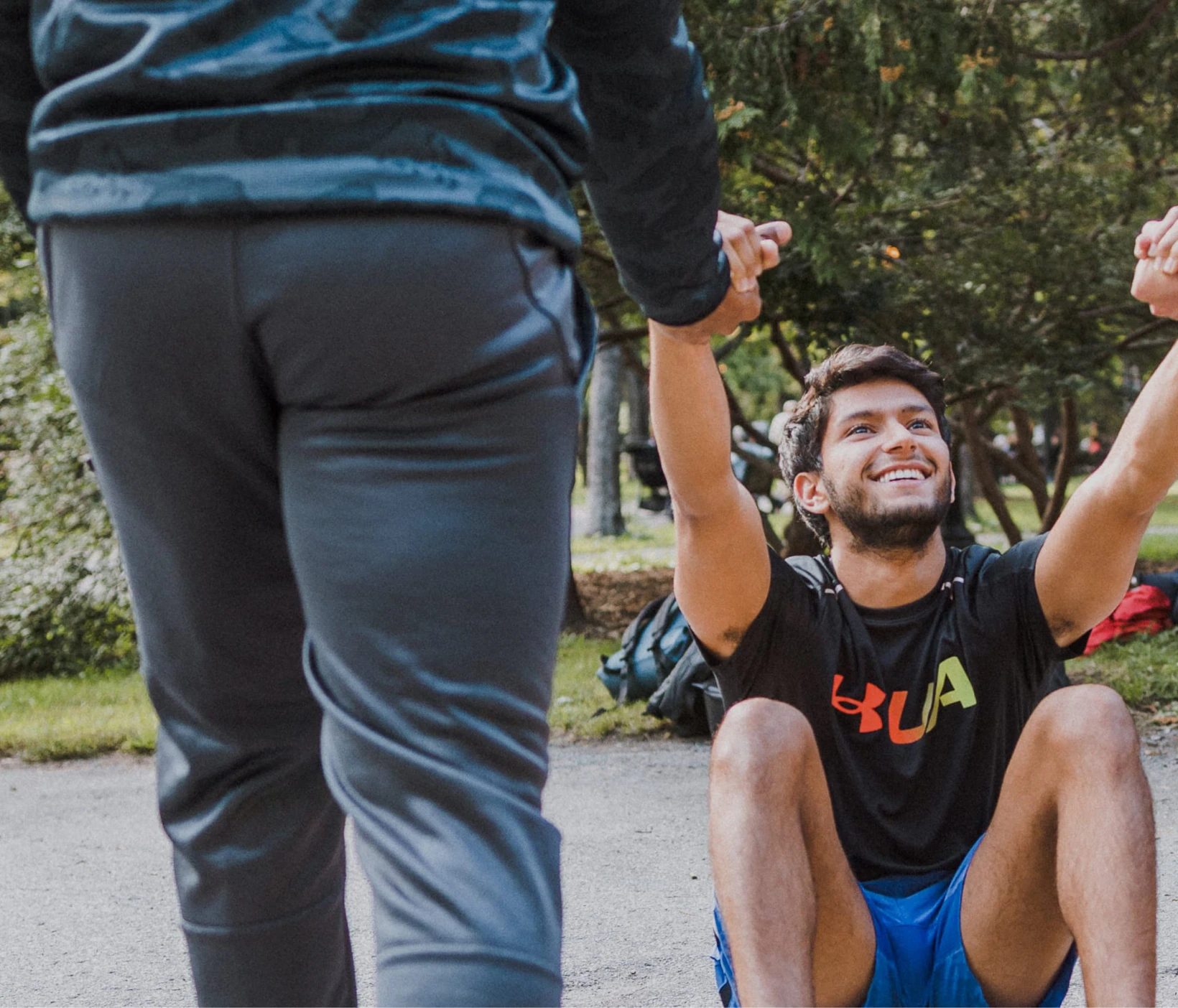
10 min read
Summary
Some essential prerequisites for getting started on half-marathon preparation
📆 Running regularly for a year
🚀 Having several 10K races under your belt
👍 Complete at least three workouts per week
Our guide to determining your specific pace during a half-marathon workout: MAS? Duration of maintenance?
What are the mandatory workouts for preparing for a half-marathon?
🐢 Jogging, base endurance: the key to good progress
⚡️ Interval training sessions: essential for improving performance
The MAS session
30' and 60' Thresholds
The pace variation session
⏱️ The specific half-marathon pace session: setting your time goals
💪 Long run: slowly but surely

Receive advice from our passionate coaches!
When you're preparing for a half-marathon, every session is important. Some are easy while others are more demanding. Your body and mental strength are put to the test, but it's worth it! We give you some tips to properly prepare for your future workout and ace it.
Some essential prerequisites for getting started on half-marathon preparation
Before you start preparing for a half-marathon, you need to check certain prerequisites. Of course, there's no obligation! Simply, these few criteria can allow you to tackle this challenge in the best conditions.
📆 Running regularly for a year
Before you ask: no, it isn’t absolutely necessary to have been a regular runner for a year to finish a half-marathon. However, wanting everything immediately is one of the most common pitfalls that beginners face.
Taking your time is the guarantee of a successful half-marathon, but also of a positive future in running. Endurance is teaching your body to sustain effort over a long period.
Why rush to learn to run long distances? It's counterintuitive, isn't it?
That's why, at Campus, we advise you to take your time before taking the leap into a half-marathon. This way, you can enjoy running, get your body used to this type of effort, and mentally prepare to embark on complete preparation.
🚀 Having several 10K races under your belt
Sharpen your skills. Here's what we can advise you before signing up for a half-marathon. That's why we encourage you to enter a few 10K races before aiming higher (or rather, longer).
Sure, the effort is different, but that's not what's important here. Having already run in competition is a significant advantage.
The atmosphere of the pack, the stress in the SAS, the pre-race organization, the fueling, etc. are all elements that should ideally be known before starting a half-marathon. Experience is an essential factor for serenity.
Preparing for a 10-kilometer race is a challenge that spans a shorter duration than a half-marathon. You can even consider participating in several competitions of this format in a relatively short period. For the half-marathon, planning must be different.
For all these reasons, we advise you to pin a few bibs on 10-kilometer races, popular ones like the adidas 10K Paris, or more confidential ones.

👍 Complete at least three workouts per week
We can never repeat it enough, a runner’s experience is built over time, but also through consistency. Running for at least a year is good. Doing it three times a week is perfect for starting the half-marathon.
Beware: we're not only talking about intensity sessions here. A workout is simply an outing. Jogging, interval training, long run etc, it doesn’t (really) matter!
Frequency remains the most important aspect. With Campus, you can then rely on a personalized structured plan that will allow you to efficiently prepare for your half-marathon.
Our guide to determining your specific pace during a half-marathon workout: MAS? Duration of maintenance?
First of all, know that you don’t have to precisely know your half-marathon pace when you start your race preparation. You will have plenty of time to determine it in the weeks leading up to the event. This is also what training is for, especially the so-called specific half-marathon workouts!
On the other hand, it's better to have an idea, even if not precise, of your goal time. For that, you can think in terms of percentage of MAS (Maximal Aerobic Speed).
Traditionally, it’s believed that an experienced runner runs a half-marathon at about 85% of his/her MAS. For a more typical runner profile: a beginner or someone with a lighter background, running at 80% of his/her MAS is considered optimal. If you want to calculate your MAS, we refer you to this comprehensive article. You will find detailed methods there.
However, at Campus, this is not the approach we have chosen. Indeed, MAS is a data point that can tend to vary depending on the test practiced. That's why we prefer to think in terms of maintenance time.
So, when you embark on a training plan, you'll need to report your times from races you've previously run in competition. If you have no reference, don't panic! You can do a test workout on 1,500 meters to allow us to give you a time estimate for your future half-marathon. From these data, we will provide you with an estimate that will refine as your training weeks progress.
Third option: you can use our pace calculator by entering your own data directly. You will thus obtain your own estimate. It's practical, but riskier!
What are the mandatory workouts for preparing for a half-marathon?
Once everything is ready, it's time to start your preparation. It consists of various types of workouts, all essential for progress. For each workout, there are some specific tips that help you optimize the benefits.
🐢 Jogging, base endurance: the key to good progress
Ah, base endurance… so simple yet so complex! Specifically, this pace accounts for about 70% of your training volume. It's present during your warm-ups, during recovery jogs and on your long runs. Needless to say, you can't avoid it!
Specifically, these workouts are done at less than 75% of your Maximum Heart Rate. Nothing insurmountable then. Yet they may be one of the biggest traps in your preparation. Indeed, you will have to respect the initial agreement: run slowly.
In Campus plans, we provide you with a pace range calculated based on your goal. If you can consider slowing down in case of fatigue, it's forbidden, however, to speed up.
Indeed, running your jogs too quickly leads to unforeseen fatigue that will add to the one caused by intense workouts. As a result, you won't be able to give your best during the intense ones. A real vicious cycle sets in: less recovery, slowed progress, discouragement, risk of injury, the possibility of missing your goal.
So slow down, enjoy the scenery, and come back home as fit as you started!

⚡️ Interval training sessions: essential for improving performance
Here we get into the tough stuff. Interval sessions are the ones that challenge you the most. In a Campus half-marathon plan, they focus on five main types:
the MAS session
the 30' Threshold session
the 60' Threshold session
the pace variation session
the specific session (and the strength coupled with the specific pace)
Specifically, you will find MAS and 30' Threshold workouts at the start of the plan. The 60' Threshold and pace variation workouts will occur in the middle of the plan. Finally, the last phase of your preparation will focus on the specific half-marathon pace.
The MAS session
Short but intense. This is how the MAS session in Campus plans can be summarized. We aim for a fast pace on short intervals. The stated goal is simple: develop your speed qualities, your aerobic power, and incidentally, your running form.
Indeed, beyond developing your physiological qualities, the high speed is ideal for adopting a dynamic stride and maintaining relaxation in the face of discomfort. Be vigilant and don’t let your stride degrade when it starts to get challenging. Of course, it will also be an opportunity to work on your mental strength.
A little advice: during the first intervals, stay within the target pace range. A workout is considered successful if you manage to perform your repetitions at a steady pace. Starting too fast guarantees you'll crash and have a painful memory of the session. It will also be counterproductive.
30' and 60' Thresholds
These sessions, presented as such, are rather specific to Campus. Again, they rely on maintenance time.
Specifically, the 30' Threshold corresponds to a pace you can maintain for 30 minutes when you’re in shape and well-rested. The 60' Threshold refers to a pace you can maintain for an hour under the same conditions. We're talking about optimal conditions! It's normal for these paces to seem difficult to maintain during your half-marathon preparation workouts.
These two types of training aim to develop your aerobic capacity. The effort intervals are longer but less intense than in MAS sessions.
At Campus, we traditionally describe these paces as "comfortably difficult." Again, you must not get carried away, especially during the initial repetitions. Maintain a sustained rhythm that allows you to keep a noticeable but controllable breathing.
During the last intervals, focus on relaxation. Feel the differences between a tense run and a relaxed effort in terms of running economy. It's the best way to learn to react well during a slump in your competition.
The pace variation session
As the name suggests, this session combines several types of pace in one workout. It allows you to work on pace changes. You also learn to feel your speed more and to know which zone you're in.
This training is often appreciated because it's particularly fun. Monotony is broken by the variation of paces.
However, be careful: don't slack off after a slow interval, and don't get carried away after a fast interval. The differences between repetitions must be well-marked. This may require good concentration, especially at the start of your preparation.

⏱️ The specific half-marathon pace session: setting your time goals
The specific half-marathon pace session is likely the one you're most looking forward to. However, it's also the one you'll see last. Indeed, your plan is designed to optimize all the necessary qualities to estimate a goal close to your capabilities.
Once all your markers are elevated, you can start setting the pace you will need to maintain on the day. Concretely, this will be done in the form of pace blocks, placed during specific workouts and long runs. You'll embed your target pace into your legs and mind.
We're not going to lie, in the first workouts, you'll probably wonder how it's possible to run 21.095 kilometers at such a pace. That's normal. The goal is to be ready on the starting line to reach your objective. Not two weeks before, not two weeks after, but on the day of the race.
We understand that this can be mentally challenging. But trust your plan. If your objective is realistic, you’ll be ready.
💪 Long run: slowly but surely
Runners' opinions on this outing are mixed. Some dread it, others eagerly anticipate it each week. Either way, it's an essential part of your half-marathon preparation.
Let’s bring some nuance: you may have heard about the long runs of future marathoners and their impressive mileage. Here, we're preparing for a half-marathon. They won't be as extensive!
Depending on your target time, the duration of the long run will be about 1 hour and 30 minutes maximum. It can include speed blocks from the beginning of the preparation, and will include specific speed at the end of preparation.
You should not fear this run but see it for what it is: a long, low-intensity workout, allowing you to accumulate a nice mileage. To prevent it from causing too much fatigue, make sure to adhere to the speeds on the base endurance sections.
Similarly, most of the speed blocks at the start and middle of the preparation are optional. It’s not just a small line added by chance! In case of fatigue, mental strength exhaustion, or any minor pain, remain in base endurance throughout the run.
__________________________
Finally, to prepare for a half-marathon, each workout has its own tips. Overall, you can remember that you must respect the target speeds of each workout. The best thing is, of course, to understand the goal of your workout so you can focus on the adaptations to be implemented. At Campus, you will find comments and advice from the coaches for each workout to approach it in the best conditions.
In conclusion, mastering your half marathon performance comes down to smart training and understanding your running pace. By incorporating various workouts like tempo runs and even a 10k or a 5k race into your training plan, you can determine how fast you can truly run a half marathon. Focus on maintaining your target pace per mile, whether that's a brisk 7 minutes per mile or a more comfortable average pace. Remember, it's not always about going fast or slow all the time; running/walking can be a valid strategy for some. Ultimately, consistent effort, smart pacing, and listening to your body will help you achieve your desired finish time. And don't forget that you are building the endurance to hold that pace during your long runs.
So now, it’s your turn!

Nolwenn
share

Receive advice from our passionate coaches!
In the same category
Share this post






